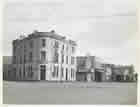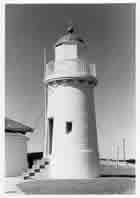Gold rush hotspots in the south west region were places like Steiglitz and Smythesdale. The town reached its peak in 1865 but once the gold ran out was finished apart from the brief revival in 1895. The lonely Steiglitz Court House is a startling expression of how fleeting life could be for a gold town.
Geelong, its port rivalling Melbourne, was almost deserted at the outbreak of gold fever. Soon however Geelong teemed with diggers. Some stopped off on their way to Ballarat, tramping across Batesford Bridge. Others came to play. After all, unlike the rudimentary gold field villages, Geelong was a substantial town with theatres and hotels where diggers could spend their newfound wealth.
Some of the many hotels that sprang up were substantial monuments to the golden age of travel like the Terminus with its 46 bedrooms and ballroom. Others had names resonant of the era, such as the Golden Age built in 1854.
Many diggers, lucky and unlucky, returned to Geelong to live. The Iron Store is a rare survivor of the many prefabricated structures imported to cope with the shortages of housing and materials during this population boom.
Geelong’s population almost trebled in the first decade of gold but by the late 1860s it entered a period of stagnation. It would not recover until the twentieth century when its improved ports and industrial expansion proved to be more enduring assets than gold.
Sealers and whalers were the first European inhabitants of Portland and Port Fairy, but by the 1850s these frontier ports had grown to busy towns with diverse commercial and agricultural interests. Warrnambool, settled from the land in the 1840s, was competing with other ports in the steamers trade by the early 1850s. The gold immigrants, expanding towns and the rich spoils of the hinterland meant new markets and profitable cargoes. Warrnambool, surrounded by fertile agricultural blocks and closer to Melbourne markets, emerged as the main player. Portland and Port Fairy went into decline. The Lady Bay Lighthouse was built in 1858 to help navigation in Warrnambool harbour.
The colony’s mining industry and its extensive railway and wharf building meant there was a huge demand for timber. Inevitably the heavily wooded Otway forests attracted timber cutters and sawmillers. In the early 1850s places like Apollo Bay and Lorne grew up to service the timber workers. Timber from the Otways was used for the Geelong and Ballarat railways. Henry’s No 1 Mill in eastern Otways supplied timber to south west towns and the Ballarat goldfields.
Although only a small pocket of the south west region saw any gold mining, the influence of gold resounded through the whole region. Wayside settlements like Colac, Camperdown and Hamilton developed into towns. Hamilton assumed the role of the capital of the Western District. Eventually the supremacy of the Western District squatters was challenged by settling gold immigrants with their cry to unlock the lands.
This text is reproduced from the publication, 'A Golden Heritage: Victoria 150' (2001) with the kind permission of Heritage Victoria





